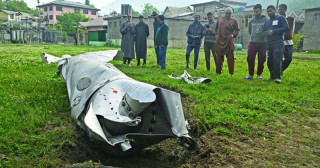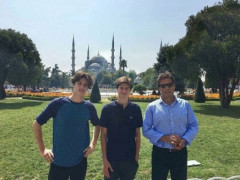moazzamniaz
Chief Minister (5k+ posts)
By Daily Mail Reporter
Last updated at 7:26 AM on 11th March 2011
- People in cars try to outrun waves on coastal highways
- Tokyo's Disneyland car park under water
- Hundreds injured after ceiling caves in at Tokyo graduation ceremony
- Physicist describes event as one of history's 'great quakes'
- Buildings rocked in China's capital Beijing, 1,500 miles away
The earthquake, measuring 8.9 on the Richter scale, sent ten-metre waves surging inland and caused fires in Tokyo.
Japan's meteorological agency said the tsunami struck Sendai, which has a population of about one million.
Drivers were seen fleeing the waves on highways close to the coast as the impact of the huge quake swept ashore while the car park at Disneyland in Tokyo was submerged.








Dramatic footage showed the surge washing away cars, a bridge and buildings at the mouth of the Hirose-gawa River, which flows through the centre of Sendai, while a roof caved in at a graduation ceremony in Tokyo.
A large ship swept away by the tsunami rammed directly into a breakwater in Kesennuma city in Miyagi prefecture, according to footage on public broadcaster NHK, and numerous people are believed to have been injured.
Officials were trying to assess possible damage from the quake but had no immediate details.
The quake that struck 2:46pm was followed by a series of aftershocks, including a 7.4-magnitude one about 30 minutes later. The U.S. Geological Survey upgraded the strength of the first quake to a magnitude 8.9.



Wide impact: A U.S. Geological Survey map shows the location of the quake while Yurikamome train passengers walk on the elevated track towards Shiodome Station in Tokyo's Shiodome district
The meteorological agency issued a tsunami warning for the entire Pacific coast of Japan. National broadcaster NHK was warning those near the coast to get to safer ground.
The Pacific Tsunami Warning Center in Hawaii said a tsunami warning was in effect for Japan, Russia, Marcus Island and the Northern Marianas. A tsunami watch has been issued for Guam, Taiwan, the Philippines, Indonesia and the U.S. state of Hawaii.
The quake struck at a depth of six miles (10 kilometres), about 80 miles (125 kilometres) off the eastern coast, the agency said. The area is 240 miles (380 kilometre) northeast of Tokyo.


In downtown Tokyo, large buildings shook violently and workers poured into the street for safety. TV footage showed a large building on fire and bellowing smoke in the Odaiba district of Tokyo.
In central Tokyo, trains were stopped and passengers walked along the tracks to platforms.
Footage on NHK from their Sendai office showed employees stumbling around and books and papers crashing from desks.
More...
- High winds cause havoc on roads: Pedestrian killed after lorry overturns in city centre
- ‘Global warming destroying archaeological treasures’ frozen for thousands of years
Several quakes had hit the same region in recent days, including a 7.3 magnitude one on Wednesday.
Thirty minutes after the quake, tall buildings were still swaying in Tokyo and mobile phone networks were not working. Japan's Coast Guard has set up task force and officials are standing by for emergency contingencies, Coast Guard official Yosuke Oi said.
'I'm afraid we'll soon find out about damages, since the quake was so strong,' he said.


Last edited by a moderator:









































